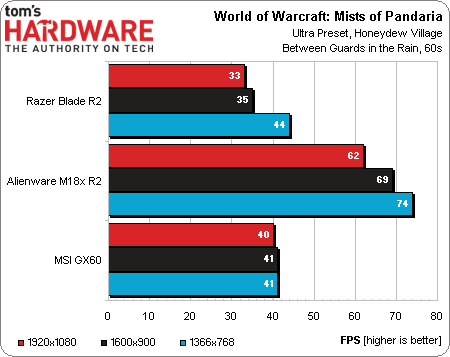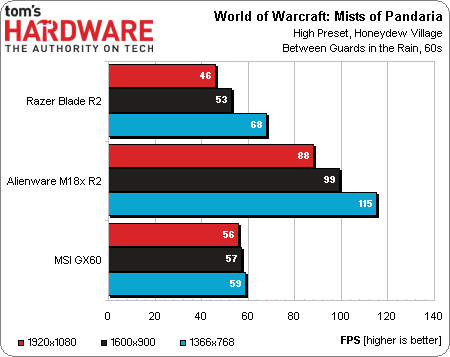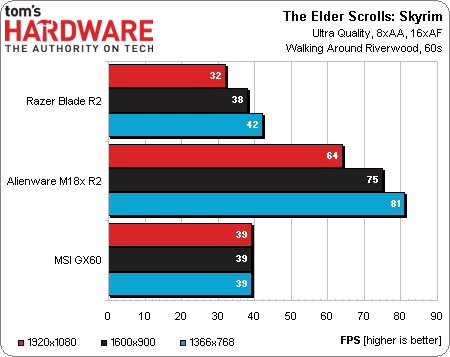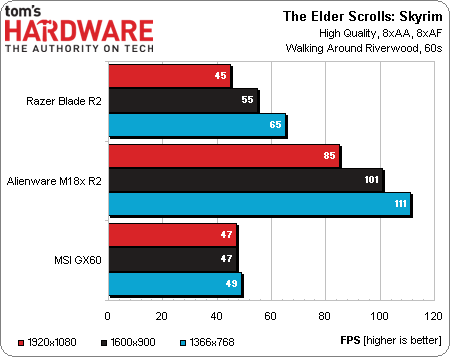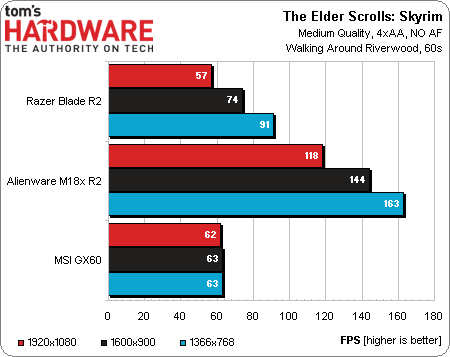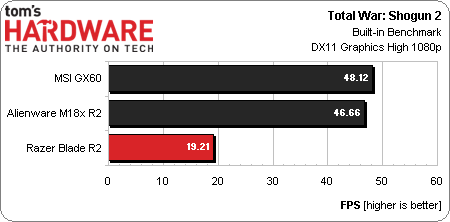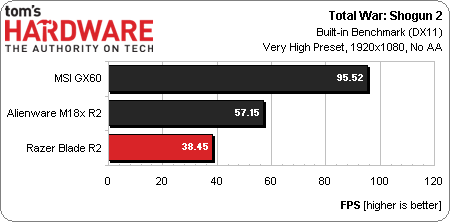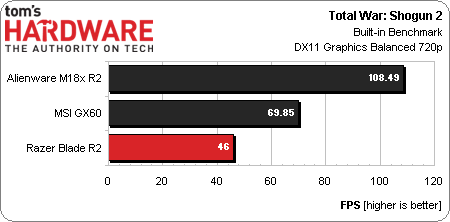Razer's Second-Generation Blade Notebook Review: Focusing On The Z
Razer recently sent us its second-gen Blade, complete with a Core i7-3632QM quad-core CPU and GeForce GTX 660M. Eight gigabytes of memory, a 500 GB hard drive, and an SSD cache round out this 17" gaming notebook. Would you believe it's less than 1" thick?
Mists of Pandaria, Skyrim, And Shogun 2
World of Warcraft: Mists of Pandaria
World of Warcraft: Mists of Pandaria offers a lush expansion with highly-detailed new worlds. One of the most demanding sections of the game is in Honeydew Village. Placing a character directly in-between the guards at the entrance to the city when it is raining, then panning the camera to just above the grassy hill beside them brings a very high number of moving objects into view. It is one of the worst-case scenarios that we have found in the game.
The GeForce GTX 660M averages more than 100 FPS in older sections of the game at Ultra settings, but only manages 33 FPS in this specific test. We had no trouble questing or raiding with the Blade R2 set to Ultra at 1920x1080, though.
The High preset brings average frame rates up, but doesn't necessary make the experience any smoother. We're comfortable operating the Blade R2 at WoW's Ultra detail preset.
At the Medium preset, a platform bottleneck once again hurts AMD's APU, putting the Blade's GeForce GTX 660M ahead of the Radeon HD 7970M.
The Elder Scrolls V: Skyrim
Benchmark settings for Elder Scrolls V: Skyrim are the same as those in Elder Scrolls V: Skyrim: PC Performance, Benchmarked.
Get Tom's Hardware's best news and in-depth reviews, straight to your inbox.
The Blade R2 has no problems playing Skyrim at its highest settings.
The average frame continues going up as detail settings are dropped, although we don't think is necessary on the Blade or our comparison machines.
Total War: Shogun 2
The built-in benchmark for Shogun 2 takes the Blade's GeForce GTX 660M under 20 FPS. This is mainly due to the game's anti-aliasing.
Turning off anti-aliasing doubles average frame rates to a very playable 38 FPS.
Running the built-in 720p benchmark yields 46 FPS. We prefer to leave AA turned off and play the game at 1080p with everything else maxed-out.
Current page: Mists of Pandaria, Skyrim, And Shogun 2
Prev Page Hitman: Absolution, DiRT, And Arkham City Next Page AC And Battery Testing-
ShadyHamster Having all the I/O on the left isn't such a bad idea, keeps the right side clear so cables don't get in the way if you use a mouse close to your laptop like i do.Reply -
mayankleoboy1 Wow, this is a very thorough review! Great work!Reply
This notebook has looked into almost every possible detail. I was particularly impressed that in the heat run, the "WASD" key area was cooler than the rest. This bespeaks extreme attention to details. -
Chairman Ray This is an amazing system. Great job by Razer! I won't be buying it due to the steep price tag, but definitely going to recommend it to those who are willing to pay for the best.Reply -
xpeh While the price is steep, this laptop is definitely one of the best looking gaming laptops I've ever seen.Reply -
g-unit1111 I very badly need to get a new laptop but this one is way too rich for my blood. I would definitely consider this if it were about $1K less.Reply -
Pyree g-unit1111I very badly need to get a new laptop but this one is way too rich for my blood. I would definitely consider this if it were about $1K less.Lenovo Y580/Y500 GT650m SLIReply -
slomo4sho xpehWhile the price is steep, this laptop is definitely one of the best looking gaming laptops I've ever seen.IMO having a $1000 gaming desktop and spending $500-600 on a laptop when Haswell comes out is probably much more economical for the occasional gaming on a laptop paired with a sold desktop to enjoy the higher quality graphics. Even at $2500, this laptop can't even keep up with the $500 budget gaming build from last month.Reply -
de5_Roy nice review. :)Reply
my real amusement came from the apu-powered laptop's performance, though. it bottlenecked the discreet gpu so badly.... :D -
corvak Gaming laptops have never been priced in a range that makes them worth buying for me. They don't really have enough battery life to really take advantage of portability, and the price/performance is in a whole other league if you compare it to any desktop build.Reply
Even buying a cheap laptop for travel use alongside a gaming desktop is likely to come in cheaper than many of these.
-
Goose_Nipples ARMY'S KA-Bar?!?!?!?! Hooooooold up my friend. Devil dog here who's jimmies have most assuredly been rustled.Reply
